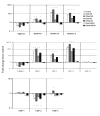S100A8 and S100A9 in experimental osteoarthritis
- PMID: 20105291
- PMCID: PMC2875644
- DOI: 10.1186/ar2917
S100A8 and S100A9 in experimental osteoarthritis
Abstract
Introduction: The objective was to evaluate the changes in S100A8 S100A9, and their complex (S100A8/S100A9) in cartilage during the onset of osteoarthritis (OA) as opposed to inflammatory arthritis.
Methods: S100A8 and S100A9 protein localization were determined in antigen-induced inflammatory arthritis in mice, mouse femoral head cartilage explants stimulated with interleukin-1 (IL-1), and in surgically-induced OA in mice. Microarray expression profiling of all S100 proteins in cartilage was evaluated at different times after initiation of degradation in femoral head explant cultures stimulated with IL-1 and surgically-induced OA. The effect of S100A8, S100A9 or the complex on the expression of aggrecan (Acan), collagen II (Col2a1), disintegrin and metalloproteases with thrombospondin motifs (Adamts1, Adamts 4 &Adamts 5), matrix metalloproteases (Mmp1, Mmp3, Mmp13 &Mmp14) and tissue inhibitors of metalloproteinases (Timp1, Timp2 &Timp3), by primary adult ovine articular chondrocytes was determined using real time quantitative reverse transcription polymerase chain reaction (qRT-PCR).
Results: Stimulation with IL-1 increased chondrocyte S100a8 and S100a9 mRNA and protein levels. There was increased chondrocyte mRNA expression of S100a8 and S100a9 in early but not late mouse OA. However, loss of the S100A8 staining in chondrocytes occurred as mouse OA progressed, in contrast to the positive reactivity for both S100A8 and S100A9 in chondrocytes in inflammatory arthritis in mice. Homodimeric S100A8 and S100A9, but not the heterodimeric complex, significantly upregulated chondrocyte Adamts1, Adamts4 and Adamts 5, Mmp1, Mmp3 and Mmp13 gene expression, while collagen II and aggrecan mRNAs were significantly decreased.
Conclusions: Chondrocyte derived S100A8 and S100A9 may have a sustained role in cartilage degradation in inflammatory arthritis. In contrast, while these proteins may have a role in initiating early cartilage degradation in OA by upregulating MMPs and aggrecanases, their reduced expression in late stages of OA suggests they do not have an ongoing role in cartilage degradation in this non-inflammatory arthropathy.
Figures






Similar articles
-
Alarmins S100A8 and S100A9 elicit a catabolic effect in human osteoarthritic chondrocytes that is dependent on Toll-like receptor 4.Arthritis Rheum. 2012 May;64(5):1477-87. doi: 10.1002/art.33495. Arthritis Rheum. 2012. PMID: 22127564
-
Stimulation of chondrocyte-mediated cartilage destruction by S100A8 in experimental murine arthritis.Arthritis Rheum. 2008 Dec;58(12):3776-87. doi: 10.1002/art.24074. Arthritis Rheum. 2008. PMID: 19035520
-
Myeloid-related proteins S100A8/S100A9 regulate joint inflammation and cartilage destruction during antigen-induced arthritis.Ann Rheum Dis. 2008 Dec;67(12):1750-8. doi: 10.1136/ard.2007.077800. Epub 2007 Nov 30. Ann Rheum Dis. 2008. PMID: 18055478
-
Proteases involved in cartilage matrix degradation in osteoarthritis.Biochim Biophys Acta. 2012 Jan;1824(1):133-45. doi: 10.1016/j.bbapap.2011.06.020. Epub 2011 Jul 8. Biochim Biophys Acta. 2012. PMID: 21777704 Free PMC article. Review.
-
Drivers of phenotypic variation in cartilage: Circadian clock genes.J Cell Mol Med. 2021 Aug;25(16):7593-7601. doi: 10.1111/jcmm.16768. Epub 2021 Jul 2. J Cell Mol Med. 2021. PMID: 34213828 Free PMC article. Review.
Cited by
-
Human S100A9 protein is stabilized by inflammatory stimuli via the formation of proteolytically-resistant homodimers.PLoS One. 2013 Apr 23;8(4):e61832. doi: 10.1371/journal.pone.0061832. Print 2013. PLoS One. 2013. PMID: 23626736 Free PMC article.
-
Pro-inflammatory S100A8 and S100A9 proteins: self-assembly into multifunctional native and amyloid complexes.Int J Mol Sci. 2012;13(3):2893-2917. doi: 10.3390/ijms13032893. Epub 2012 Mar 5. Int J Mol Sci. 2012. PMID: 22489132 Free PMC article. Review.
-
Quantitative proteomics reveals regulatory differences in the chondrocyte secretome from human medial and lateral femoral condyles in osteoarthritic patients.Proteome Sci. 2013 Oct 4;11(1):43. doi: 10.1186/1477-5956-11-43. Proteome Sci. 2013. PMID: 24090399 Free PMC article.
-
The Role of Alarmins in the Pathogenesis of Rheumatoid Arthritis, Osteoarthritis, and Psoriasis.Curr Issues Mol Biol. 2024 Apr 19;46(4):3640-3675. doi: 10.3390/cimb46040228. Curr Issues Mol Biol. 2024. PMID: 38666958 Free PMC article. Review.
-
Inhibition of TLR4 signalling to dampen joint inflammation in osteoarthritis.Rheumatology (Oxford). 2024 Mar 1;63(3):608-618. doi: 10.1093/rheumatology/kead493. Rheumatology (Oxford). 2024. PMID: 37788083 Free PMC article. Review.
References
-
- Vogl T, Ludwig S, Goebeler M, Strey A, Thorey IS, Reichelt R, Foell D, Gerke V, Manitz MP, Nacken W, Werner S, Sorg C, Roth J. MRP8 and MRP14 control microtubule reorganization during transendothelial migration of phagocytes. Blood. 2004;104:4260–4268. doi: 10.1182/blood-2004-02-0446. - DOI - PubMed
-
- Cecil DL, Johnson K, Rediske J, Lotz M, Schmidt AM, Terkeltaub R. Inflammation-induced chondrocyte hypertrophy is driven by receptor for advanced glycation end products. J Immunol. 2005;175:8296–8302. - PubMed
Publication types
MeSH terms
Substances
LinkOut - more resources
Full Text Sources
Other Literature Sources
Medical
Research Materials
Miscellaneous

